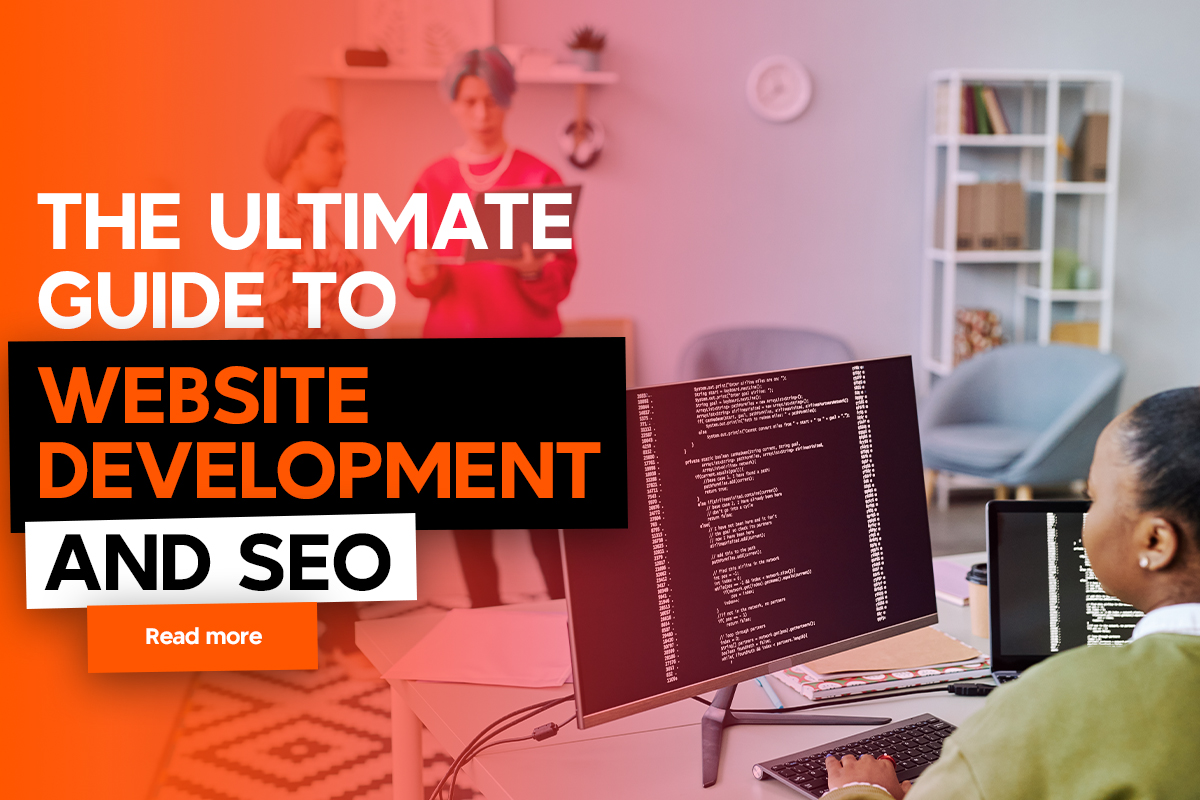
The Ultimate Guide to Website Development and SEO
In today’s digital landscape, a well-built website is essential for any business or personal brand. Website development is more than just design; it’s about creating a digital presence that reflects your identity, engages visitors, and drives results.
But building a strong website is just the beginning. To ensure it reaches the right audience, an effective SEO strategy is equally important.
In this ultimate guide, we’ll walk you through everything you need to know about website development and SEO, covering key aspects to help your website succeed in a competitive online space.
How to Build SEO-Friendly URLs and Structure
A well-organized website with SEO-friendly URLs makes it easier for search engines and visitors to find your content. An optimized URL structure not only improves your rankings but also creates a more pleasant experience for users.
But where to start? Here’s a guide to creating URLs that both search engines and people will love.
And if you need extra support, Creight, a digital marketing agency, can help you build SEO-friendly website structures that work.
Keep URLs Short and Descriptive
An SEO-friendly URL is short, to the point, and easy to read. Avoid long, complicated URLs stuffed with unnecessary words or numbers. Instead, choose a few keywords that summarize the content of each page.
For example, *yourwebsite.com/about-us* is simple, clear, and memorable. Clean URLs help search engines understand your content, which can boost your rankings.
If this sounds tricky, Creight can help you create URLs that capture the essence of your pages and are easy for users to understand.
Use Keywords Wisely
Including relevant keywords in your URLs is a great way to improve SEO, but don’t overdo it. Focus on one or two keywords that match the page’s content, like yourwebsite.com/organic-coffee instead of yourwebsite.com/best-organic-coffee-online-for-sale.
Keeping it natural helps both users and search engines. If you need guidance on keyword placement, Creight’s SEO experts know how to create optimized URLs without making them look forced.
Organize Content into a Clear Hierarchy
A clear site structure helps users and search engines navigate your content easily. For example, if you have a section on services, use URLs like yourwebsite.com/services followed by specific pages like yourwebsite.com/services/web-design.
This hierarchy tells search engines how your content is organized, helping them understand what’s most important. An organized structure makes your site easier to explore, boosting user experience and SEO. Creight can assist in developing a solid website hierarchy that’s SEO-friendly and user-focused.
Avoid Special Characters and Use Hyphens
Avoid using special characters like &, %, or # in URLs as they can confuse search engines. Instead, separate words with hyphens to make URLs more readable and search-friendly. A URL like yourwebsite.com/web-design-services is cleaner than yourwebsite.com/web_design%20services.
This small change can make a big difference in how search engines interpret your URLs. Creight’s team can help you create clean, well-structured URLs that look professional and perform well.
Make URLs Consistent and Predictable
Consistency is key for both users and search engines. Use similar structures and naming conventions across your site to make URLs predictable. When visitors and search engines know what to expect, navigation is smoother, which positively impacts SEO.
A reliable structure also shows professionalism, making your site more trustworthy. With Creight’s expertise, you can build a cohesive, SEO-friendly URL strategy that keeps your site organized and easy to navigate.

Image Optimization Tips for Faster Load Times
Images make your website more attractive and engaging, but if they’re too large, they can slow down load times. A slow-loading website frustrates users and hurts your SEO rankings.
Optimizing images is an easy way to boost speed, improve user experience, and rank better on search engines. Here are some tips for getting those images in top shape.
If you’re looking for expert help, Creight, a digital marketing agency, can guide you through image optimization as part of a broader website development strategy.
Resize Images for Web-Friendly Dimensions
Using high-resolution images is great for quality but not for speed. Large images take longer to load, which slows down your website. Before uploading, resize images to the dimensions you actually need.
For example, if a section calls for a 500×500 pixel image, don’t upload a 3000×3000 pixel one. Resizing helps your website load faster without sacrificing visual quality.
Creight can help you set the right dimensions for all your images, ensuring they look sharp and load quickly.
Choose the Right File Format
The file format you choose can impact both image quality and load times. Common formats include JPEG, PNG, and WebP.
JPEG is often ideal for photos as it compresses well while maintaining good quality. PNG is great for logos or images with transparency, but the files are larger. WebP is a newer format that combines the best of both worlds—high quality with smaller file sizes.
Choosing the right format keeps images sharp without slowing down your site. Creight’s team can help you select the best file formats to optimize your website.
Compress Images to Reduce File Size
Compression reduces the file size of images without a noticeable loss in quality, which helps your pages load faster. You can use tools like TinyPNG, JPEG-Optimizer, or built-in compression options in content management systems.
The goal is to find a balance between size and quality, so images look great and load quickly. Creight can handle image compression for you, making sure your visuals look fantastic without dragging down performance.
Use Lazy Loading for Faster Initial Load
Lazy loading means that images load only as users scroll down the page, rather than all at once. This feature reduces the initial load time of your website, especially if you have image-heavy pages.
With lazy loading, users don’t have to wait for every image to load before interacting with the site. This trick can boost user experience and SEO. Creight can implement lazy loading on your website, ensuring images appear just in time as visitors browse.
Optimize Alt Text for SEO and Accessibility
Alt text is not just for accessibility—it’s also a small SEO boost. Descriptive alt text helps search engines understand your images, and it’s essential for visually impaired users.
Including a few relevant keywords in the alt text can help with SEO, as long as it feels natural. Creight’s SEO experts can help you craft alt text that enhances accessibility and aligns with your SEO goals.
Integrating Keywords Seamlessly in Web Content
In website development, good content needs the right keywords to connect with search engines and attract readers.
But no one likes reading text stuffed with awkward, repetitive keywords. Integrating keywords smoothly into your content is an art that keeps readers engaged and boosts SEO without feeling forced.
Here’s how you can work keywords into your web content naturally. And if you want expert help, Creight’s digital marketing team knows just how to make keywords work for you.
Start with Natural Language
When it comes to keywords, think natural! Rather than forcing a keyword like “affordable web design services” into every sentence, find places where it fits naturally.
Speak as you would to a friend, and keywords will fall into place more easily. Readers and search engines appreciate content that flows.
Creight’s team can help create content that makes great use of keywords while still sounding genuine.
Use Keywords in Headers and Subheads
Keywords aren’t just for the main body of text—they work wonders in headers and subheads too. Using keywords in headings helps search engines understand what your content is about and improves readability.
A heading like “Affordable Website Development Services” can be much more powerful than burying the phrase in a long paragraph. Creight’s experts know how to optimize headers and subheads to boost your SEO in a natural way.
Sprinkle Keywords Strategically in Text
Keywords should enhance your content, not dominate it. Rather than filling every sentence with your primary keyword, use it sparingly where it makes sense. Look for opportunities to incorporate related keywords, too, like “website design” or “online presence.”
This variation makes your content more dynamic and engaging. If balancing keywords feels tricky, Creight’s content specialists can help you find the perfect mix for readability and SEO.
Leverage Keywords in Image Alt Text
Keyword integration doesn’t stop with text! Adding keywords to image alt text can improve your SEO and make your site more accessible.
Descriptive alt text, like “professional website development service,” tells search engines and visually impaired users what an image is about. Creight’s team can guide you in using alt text effectively, ensuring every part of your content is optimized for visibility.
Write for People First, Search Engines Second
At the end of the day, you’re writing for humans, not just search engines. Keyword placement should feel like a natural part of your story, not a checklist.
When you focus on creating valuable, interesting content, keywords will fit in more seamlessly. Creight’s writers understand that quality content is key and know how to make SEO work without disrupting the flow of your message.
Leveraging Internal Linking to Improve Navigation
Good internal linking helps visitors explore your website with ease, connecting them to relevant pages in just a click.
Effective linking not only guides users but also enhances your SEO by helping search engines understand your site’s structure. Internal linking is one of those small website development tactics that can make a big impact.
And if you want professional guidance, Creight’s team can create a well-connected, user-friendly website structure that boosts both SEO and user experience.
Guide Visitors Smoothly with Internal Links
Internal links are like signposts on your website, directing visitors to other valuable pages. When you guide users to related content through helpful links, you improve their experience and keep them engaged.
For example, if someone’s reading a blog on SEO tips, linking to a related post on keyword research could be very helpful. Creight can help map out an internal linking strategy that guides users smoothly from one page to the next, keeping them engaged and lowering bounce rates.
Boost SEO with Strategic Linking
Internal links aren’t just good for users—they’re great for SEO too! When search engines crawl your website, they follow links to discover new pages. By linking to important pages within your content, you show search engines which pages matter most.
For instance, linking to your services page from multiple blog posts signals its importance to search engines. Creight’s experts can set up a smart internal linking strategy that not only helps users but also tells search engines what’s valuable on your site.
Create a Cohesive Experience Across Your Site
Good internal linking creates a sense of cohesion across your website, making it feel more like a well-connected whole than a series of individual pages.
For example, linking from your homepage to your blog, then to your service pages, and back again creates a seamless experience. When users can navigate easily, they’re more likely to explore, stay longer, and even convert.
If you’re not sure how to create this cohesive experience, Creight’s website development team can handle it for you, ensuring that each link flows naturally.
Use Descriptive Anchor Text for Clear Navigation
Anchor text—the clickable text in a hyperlink—should be clear and descriptive. Avoid generic phrases like “click here” and instead use specific terms, like “learn more about our web design services.”
This improves user experience by telling visitors exactly where the link will take them. Clear anchor text also provides search engines with context, boosting SEO. Creight can help you craft descriptive, relevant anchor text that enhances navigation and search engine understanding.
Mastering website development and SEO can seem challenging, but the results are worth it. With these strategies—and Creight’s expertise in digital marketing—you can build a site that attracts, engages, and ranks well. Dive confidently into your web journey, knowing you have the right tools for success.


